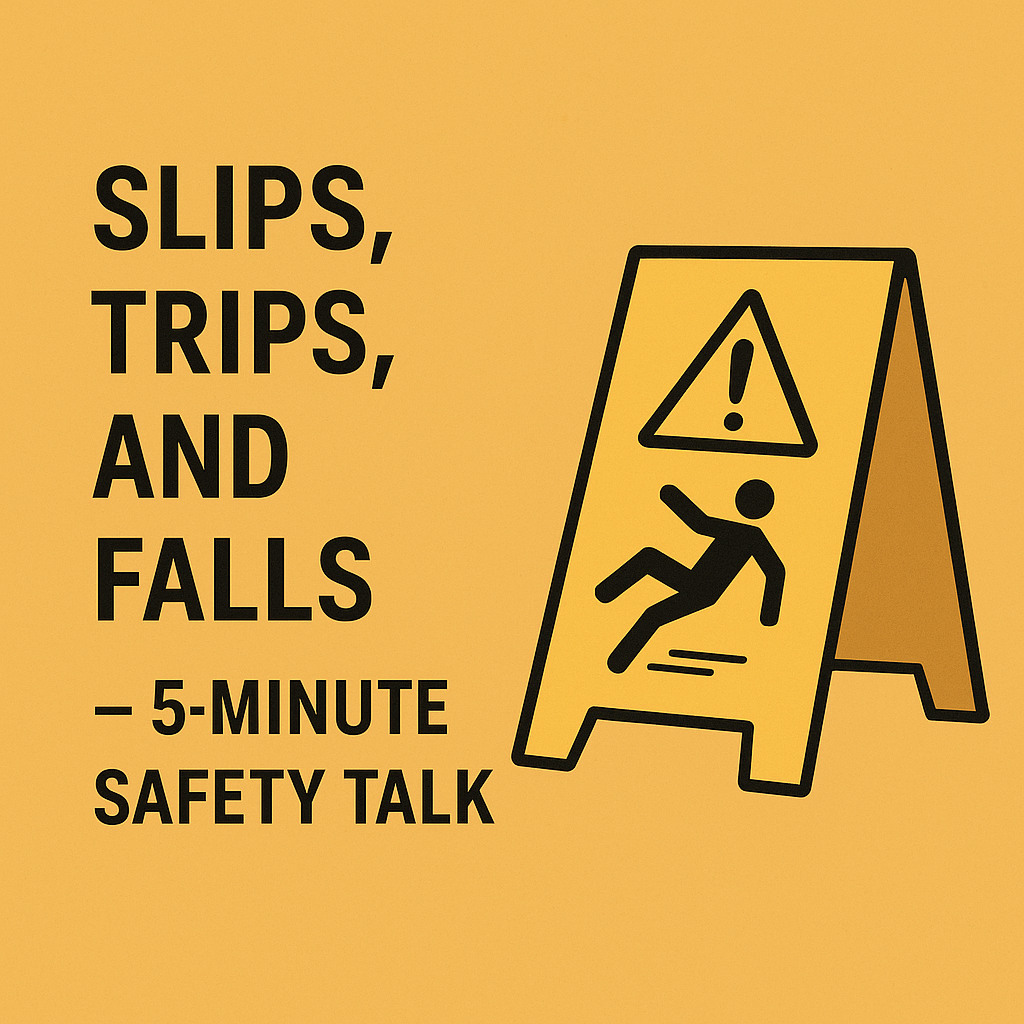
Slips Trips and Falls 5 Minute Safety Talk
Good morning team,
Today we’re going to talk about something that might sound minor but is actually one of the most common causes of workplace injuries—Slips, Trips, and Falls.
These incidents don’t always involve heights or ladders. In fact, many happen on the same level—from wet floors, uneven surfaces, poor lighting, or just not paying attention. And while they might seem harmless, they can lead to serious injuries like sprains, broken bones, head trauma, or even fatalities.
So let’s take the next five minutes to review how we can prevent these types of accidents and keep ourselves and our coworkers safe.
Why Are Slips, Trips, and Falls So Dangerous?
Because they can happen anywhere, anytime. One moment you’re walking normally, the next you’re on the ground.
Consequences include:
- Broken bones
- Head and back injuries
- Time off work
- Long-term pain or disability
- Legal and financial consequences for the company
Many of these incidents are completely preventable with simple precautions.
What Causes Slips?
Slips happen when your feet lose grip on the walking surface.
Common causes:
- Wet or oily floors
- Spilled liquids or food
- Polished or freshly cleaned floors
- Snow, ice, or rain tracked inside
- Smooth footwear on slick surfaces
Prevention tips:
- Clean up spills immediately
- Use “Wet Floor” signs
- Wear non-slip footwear
- Use absorbent mats in entrances
What Causes Trips?
Trips occur when your foot strikes an object or uneven surface, causing you to lose balance.
Common trip hazards:
- Loose cables or extension cords
- Cluttered walkways
- Uneven flooring or broken tiles
- Open drawers or tools left out
- Poor lighting in work areas
Prevention tips:
- Keep walkways clear
- Tape down cords or use cord covers
- Mark elevation changes with high-visibility tape
- Improve lighting in dark areas
What Causes Falls?
Falls usually happen when working from height, but they can also occur at ground level.
Risk areas:
- Ladders
- Scaffolds
- Unprotected edges or floor openings
- Stairs without handrails
- Sloped or slippery surfaces
Fall prevention tips:
- Use fall protection equipment (harness, lanyard)
- Always maintain 3 points of contact on ladders
- Use proper ladder positioning
- Install guardrails or edge protection
- Don’t carry items that block your view on stairs
Situational Awareness Is Key
Many slips, trips, and falls happen when people are:
- Distracted (using phones while walking)
- Rushing
- Carrying too much at once
- Not wearing the right footwear
Stay alert, move carefully, and watch your step—literally.
Use the Right Tools
Sometimes accidents happen simply because we didn’t use the right tools for the job.
- Use step ladders instead of chairs
- Use tool belts to keep hands free
- Use carts or trolleys for heavy loads
- Use flashlights in dark areas
Smart tools = safer work.
Quick Slips, Trips, and Falls Checklist
- Are floors dry and clean?
- Are walkways clear of obstacles?
- Are cords secured and taped down?
- Is proper footwear being worn?
- Are ladders and stairs in good condition?
- Are spills cleaned up immediately?
If not—stop and fix it.
Real-Life Example
A worker in a warehouse slipped on a small oil patch that had leaked from a forklift. No sign was posted, and the spill hadn’t been cleaned. The fall resulted in a fractured hip and months of recovery.
One tiny spill led to big consequences. A simple fix—like using a spill kit right away—could’ve prevented it.
Your Role in Prevention
Here’s how you can help:
- Report hazards immediately
- Don’t walk past spills or trip hazards—take action
- Clean as you go
- Always wear the right PPE and shoes
- Encourage your coworkers to do the same
A safety culture starts with small daily habits.
Conclusion
Slips, trips, and falls aren’t just embarrassing—they can be painful, costly, and life-changing. The good news? They’re easy to prevent if we stay alert, maintain clean workspaces, and use the right equipment.
So take a moment today—look around your work area. Clear that cord, clean that spill, move that box.
Because in safety, the little things matter the most.
Fire Safety 5 Minute Safety Talk
Electrical Safety 5 Minute Safety Talk
Personal Protective Equipment – PPE 5 Minute Safety Talk
Housekeeping 5 Minute Safety Talk
Create Your Own Toolbox Talk Presentation – Step-by-Step
5 Unique FAQs
Q1: Do I need to report a slip even if I didn’t get hurt?
Yes! Near-misses are red flags. Reporting them can prevent future accidents.
Q2: What kind of shoes should I wear to prevent slipping?
Shoes with non-slip, oil-resistant soles are best—especially in wet or oily areas.
Q3: Are same-level falls really that serious?
Absolutely. Many fractures and head injuries happen from falls on flat surfaces.
Q4: Should I clean a spill even if it’s not my area?
Yes. Safety is everyone’s responsibility. Clean it or report it right away.
Q5: What if I can’t reach something without climbing on a chair?
Don’t risk it. Use a ladder or step stool designed for the task.